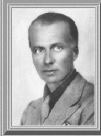MUSIC OF GIACINTO SCELSI
Greg Kucera Gallery, 212 Third S., 624-0770, $10 8 p.m. Fri., April 26
MOST OF US have had the experience of turning on the radio and being transfixed by the unfamiliar music coming out of it. It happened to Chris Camarda, founder-winemaker of Vashon Island’s famed boutique winery Andrew Will, some years ago. “It was like no music I’d ever heard before. It wasn’t like music at all. I had to hear more.”
The music Camarda heard was the work of Giacinto Scelsi, until recently an obscure figure in 20th-century music and still one of the strangest. The greater part of Scelsi’s output is yet to be recorded. But since the mid-1960s (he died in 1982), a small band of passionate enthusiasts for his music have dragged significant fragments into the light, enough to show that what we’ve heard up until now are only glimpses through the clouds of a musical Himalaya. Scelsi (easier than it looks: “SHELL-see”) was one of the big ones.
Thanks to Camarda’s financial backing, Seattle gets a chance this week to hear Scelsi performed, including one piece by the virtuoso he wrote it for, in a venue that perfectly accommodates the man’s genre-busting approach to making music: Greg Kucera’s stylishly bare art gallery off Pioneer Square.
Scelsi was born in 1905 into a wealthy and aristocratic Neapolitan family. He doesn’t seem to have suffered much from the 30 years of war and turmoil that gripped Europe during his early life, but he was always something of a loner (maybe growing up with the name “Hyacinth” had something to do with it), and toward the end of World War II, he had a nervous breakdown, which he “treated” by sitting for hours on end playing the same note over and over on the piano. His wife also left him; whether those therapeutic noodlings had anything to do with her departure his biographers do not make clear.
They were Scelsi’s salvation as an artist, though. Before his breakdown, he’d composed in a number of styles, ranging from strict formalism to passionate rhapsody. Through his one-note piano exercises, he discovered the fascination of pure sound, devoid of structure, pulse, and “meaning.” But since one piano note sounds very much like another, Scelsi soon began writing for instruments providing more range of color within a single note.
During the mid-1950s he sketched out sound-centered pieces for a wide range of solo wind instruments, including the French horn. A more unpromising instrument for sonic experiments would be hard to name. Unlike the trombone, with its slippery slide, the horn doesn’t give its player a lot of control over the sound it makes: a kind of noble bleat, very agreeable as a special effect but a little bland when administered in large doses.
Experimental as always, Scelsi goes totally against the instrument’s grain, encouraging the player to force its sound from bleat to blat, while simultaneously stuffing and withdrawing his right hand from the instrument’s flaring bell to produce an amazing range of nasal, snarling noises. The result is a kind of three- dimensional monochrome soundscape, with individual notes like dabs of intense black pigment suspended at varying distances in empty space.
Seattle horn virtuoso David Kappy will play the four pieces for horn at Kucera, while composer William O. Smith, himself an inventor of new sounds and techniques for the clarinet, will render Ixor, a solo work from the same year as the Four Pieces.
But the centerpiece of the Scelsi event is the first Seattle appearance of Frances-Marie Uitti, a passionate advocate of Scelsi’s music and even, to a certain extent, his muse. Toward the end of his career, Scelsi composed a lot of music for string instruments, which are capable of tiny variations in attack, pitch, and volume that fascinated him. Uitti, a young American cellist, had invented a method of playing with two bows simultaneously. Scelsi couldn’t resist the temptation and composed for her some of his most passionate music, including the mysterious, monumental Trilogia, which she will perform at Kucera. Subtitled “the three ages of man,” the work is a kind of cryptic musical autobiography as well.
For adventurous local music lovers, this is a rare chance to encounter Scelsi close up (you’re certainly not going to hear his late dithyrambs for orchestra and chorus works on a Seattle Symphony program), played by musicians who have mastered and come to love his incredibly austere, difficult music and found the elegance and heartfelt emotion beneath its shattered, roughcast surfaces.








